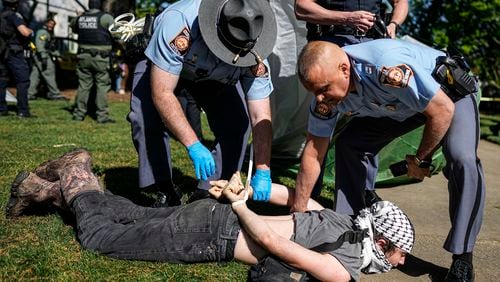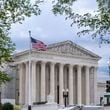The Cobb County school system is learning what billboard owners have known all along: A glance is worth money.
After the success of an unauthorized commercial sign outside Lassiter High School in east Cobb, the school system has rewritten its rules to allow advertising at schools across the county.
Lassiter has a computerized panel, erected years ago, that can display the latest information about upcoming plays, games and other events. That technology isn’t the innovation, though. What’s different is the old-tech space below the electronic display: Companies can hang a shingle with their name there.
All they have to do is pay.
So far, the venture has netted thousands of dollars for Lassiter High, with the money paying for new turf for an athletic field.
Educators elsewhere haven’t caught up to the concept that “there’s value to the eyeballs” of those who drive by a school, said Chris Burns, an advertising entrepreneur at the center of the Cobb effort. Although schools have exploited advertising on sports fields and courts for decades, they reach only a small audience of parents and students. The Cobb concept seeks a wider target.
“The school is an asset,” Burns said. “Advertise to the people who drive by rather than to students.”
Burns, a managing partner with Impact Local Marketing Group in Forsyth County, helped the Lassiter principal and school foundation assemble the structure and find advertisers. The sign is 15 by 13 feet, and has 3-by-5-foot spots for eight companies. Burns wouldn’t discuss specific pricing, but he said in a good year, with a full rotation of ads, the structure can yield $50,000.
Gas South has paid for a presence on the Lassiter sign since 2007. The company was created in 2006, and CEO Kevin Greiner credits his growing customer base — more than a quarter million — in part to the sign. He said school advertising is good for everyone because the school earns extra money while the advertisers attract appreciative customers.
“Like any new company, we were looking to introduce ourselves to the community,” Greiner said. “The business relationship with these customers tends to be deeper and longer lasting.”
Greiner was unaware of any other school system in metro Atlanta that has pursued ad dollars like this. “I think Lassiter really pioneered this notion of advertising community businesses on their marquee,” he said.
DeKalb and Clayton said they haven’t tried any advertising ventures. A Gwinnett County schools spokeswoman said advertising on a school marquee is a local school decision, but had no examples to offer.
The Forsyth County school system rejected an advertising proposal about six years ago; a local company wanted to place ads on school maintenance trucks and vans. The school board unanimously opposed the idea, board member Ann Crow said.
“We just didn’t feel like it was appropriate,” Crow said, adding that she and her colleagues worried they would be “opening the flood gates for other requests for ads” and “that is not the image we want for our school system. We did not want our schools covered in ads.”
Cobb schools aren’t covered in ads, but more signs have popped up. Pope High, also in east Cobb, built a sign similar to Lassiter’s. However, Lassiter enjoys a commercial advantage because it sits on a busier street; about 19,000 vehicles pass by each day on Shallowford Road. Those figures are dwarfed by Sprayberry High, also in east Cobb, which has 44,000 automobiles travel past each day on Sandy Plains Road.
Sprayberry High wants an ad deal, too. Another energy company, Georgia Natural Gas, has agreed to be the top sponsor of a sign that will be erected in coming weeks.
Georgia Natural Gas paid $85,000 for a 10-year contract, school board member David Banks said. The cost covers construction of the sign. Spots are available for eight other advertisers who might pay tens of thousands of dollars for three-year contracts. Since construction costs are covered, the prospective eight advertisers supply only profit. “So the school really benefits because they don’t have to do anything,” Banks said.
The success of the Lassiter sign made Banks want to replicate it at other schools. He convened a meeting with Burns and several principals this year, and that led to the deal for Sprayberry. More signs at other schools are in the works.
“If it helps out with sports programs and keeps the arts going, I think it’s great,” said Kevin Clennan, a homeowner who lives near Lassiter High. “There will be a lot less door-knocking for donations.”
In August, Cobb school officials rewrote the district rules on advertising. The new rules allow “marquee signs” that raise money for education and allow advertising on school websites. The Allatoona High School homepage already boasts a Gas South ad that offers a discount to customers who click on it.
Marquee advertising isn’t the first commercial moneymaker for Cobb, and it isn’t the first time Lassiter High has been at the forefront. The county previously embraced the sometimes controversial approval of cell towers on school property. There are 30 towers at two dozen schools — the first coming at Lassiter in 1995. The towers bring in about $700,000 per year, school system spokesman Jay Dillon said.
Banks, the Cobb school board member, said advertising is an easier way to make money: “It’s a good revenue generator, better than a cell tower. Those are controversial.”






